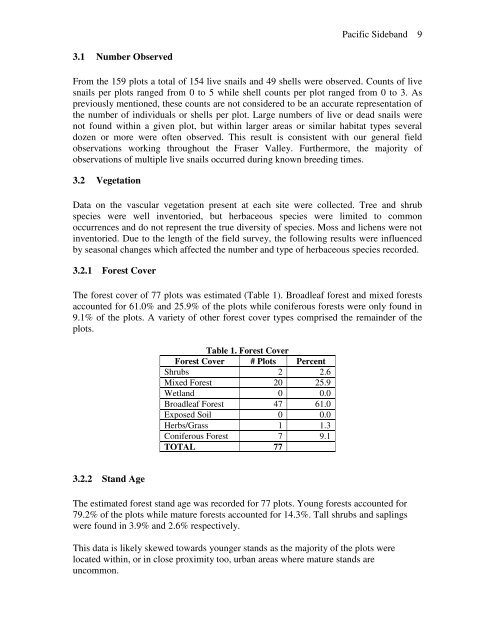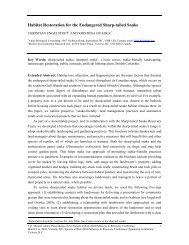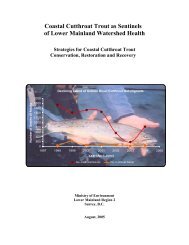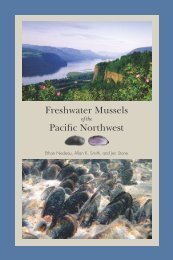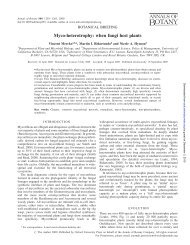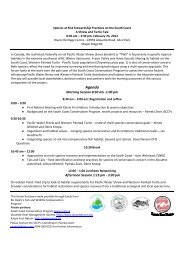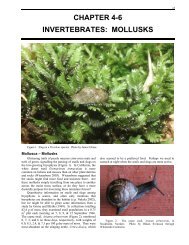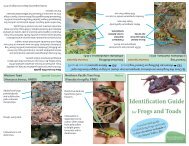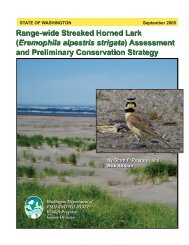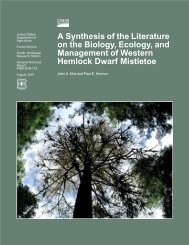Habitat Assessment of the Pacific Sideband (Monadenia fidelis) In ...
Habitat Assessment of the Pacific Sideband (Monadenia fidelis) In ...
Habitat Assessment of the Pacific Sideband (Monadenia fidelis) In ...
- No tags were found...
Create successful ePaper yourself
Turn your PDF publications into a flip-book with our unique Google optimized e-Paper software.
<strong>Pacific</strong> <strong>Sideband</strong> 93.1 Number ObservedFrom <strong>the</strong> 159 plots a total <strong>of</strong> 154 live snails and 49 shells were observed. Counts <strong>of</strong> livesnails per plots ranged from 0 to 5 while shell counts per plot ranged from 0 to 3. Aspreviously mentioned, <strong>the</strong>se counts are not considered to be an accurate representation <strong>of</strong><strong>the</strong> number <strong>of</strong> individuals or shells per plot. Large numbers <strong>of</strong> live or dead snails werenot found within a given plot, but within larger areas or similar habitat types severaldozen or more were <strong>of</strong>ten observed. This result is consistent with our general fieldobservations working throughout <strong>the</strong> Fraser Valley. Fur<strong>the</strong>rmore, <strong>the</strong> majority <strong>of</strong>observations <strong>of</strong> multiple live snails occurred during known breeding times.3.2 VegetationData on <strong>the</strong> vascular vegetation present at each site were collected. Tree and shrubspecies were well inventoried, but herbaceous species were limited to commonoccurrences and do not represent <strong>the</strong> true diversity <strong>of</strong> species. Moss and lichens were notinventoried. Due to <strong>the</strong> length <strong>of</strong> <strong>the</strong> field survey, <strong>the</strong> following results were influencedby seasonal changes which affected <strong>the</strong> number and type <strong>of</strong> herbaceous species recorded.3.2.1 Forest CoverThe forest cover <strong>of</strong> 77 plots was estimated (Table 1). Broadleaf forest and mixed forestsaccounted for 61.0% and 25.9% <strong>of</strong> <strong>the</strong> plots while coniferous forests were only found in9.1% <strong>of</strong> <strong>the</strong> plots. A variety <strong>of</strong> o<strong>the</strong>r forest cover types comprised <strong>the</strong> remainder <strong>of</strong> <strong>the</strong>plots.Table 1. Forest CoverForest Cover # Plots PercentShrubs 2 2.6Mixed Forest 20 25.9Wetland 0 0.0Broadleaf Forest 47 61.0Exposed Soil 0 0.0Herbs/Grass 1 1.3Coniferous Forest 7 9.1TOTAL 773.2.2 Stand AgeThe estimated forest stand age was recorded for 77 plots. Young forests accounted for79.2% <strong>of</strong> <strong>the</strong> plots while mature forests accounted for 14.3%. Tall shrubs and saplingswere found in 3.9% and 2.6% respectively.This data is likely skewed towards younger stands as <strong>the</strong> majority <strong>of</strong> <strong>the</strong> plots werelocated within, or in close proximity too, urban areas where mature stands areuncommon.


